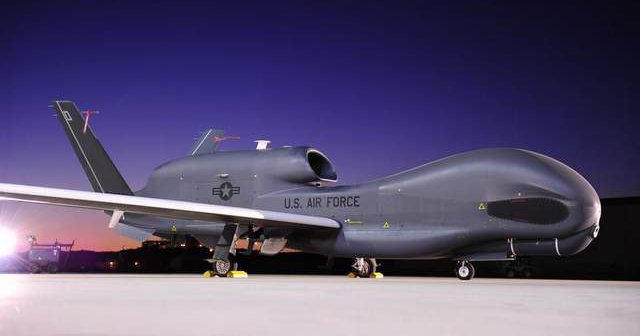The U.S. military will deploy long-range Global Hawks from Japan next year, U.S. and Japanese officials announced, marking the first time the Pentagon has been able to secure basing rights for the advanced unmanned aircraft in Northeast Asia.
The US Air Force will begin flying “two or three” Global Hawks from an undetermined base in Japan next spring, a senior U.S. administration official told reporters during a visit to Tokyo by Secretary of State John Kerry and Defense Secretary Chuck Hagel.
The primary mission will be to fly near North Korea, an area where U.S. officials hope they will greatly enhance current spying capabilities. The Air Force already has Global Hawks stationed at Andersen Air Force Base in Guam, the U.S. territory in the Pacific, but North Korea is at the edge of their range, and their flights often are curtailed because of bad weather.
The Air Force also has Global Hawks stationed in the Persian Gulf.
The unarmed aircraft carry multiple spy sensors and are the most advanced surveillance aircraft in the Air Force’s fleet. They fly at altitudes above 60,000 feet, placing them out of range of most air defenses. Without pilots in the cockpit, they can fly for more than 28 hours at a time, giving them an unmatched range of nearly 9,000 nautical miles.
The presence of Global Hawks in East Asia is sure to irritate China, which has increasingly pushed back against the U.S. military presence in the region. Officials in Beijing had criticized Tokyo in recent days over reports that the Japanese military was considering acquiring its own Global Hawks, saying the move could escalate tensions.
China also is engaged in a bitter territorial dispute with Japan over the Senkaku Islands, an uninhabited group of outcroppings in the East China Sea that Japan nationalized last year, sparking confrontations between the two countries’ ships deployed in the area.
Besides flying missions over North Korea, the Global Hawks presumably would give the United States and Japan better information about the movements of Chinese ships in the vicinity of Senkaku. The same goes for Chinese ships elsewhere in the region, such as the South China Sea, where China is mired in territorial disputes with the Philippines, Vietnam, Thailand and other countries.
In addition to the Global Hawks, P-8 maritime surveillance patrol aircraft will start to be deployed in Japan in December, U.S. and Japanese officials announced. It would be the first time the aircraft will be stationed outside the United States.
“The cutting-edge capabilities of the P-8, which I saw demonstrated last summer, will greatly enhance” the allies’ ability to conduct surveillance, particularly over the open seas, Hagel said at a joint news conference with Kerry, Japanese Defense Minister Itsunori Onodera and Foreign Minister Fumio Kishida.
Source: Trib Live

